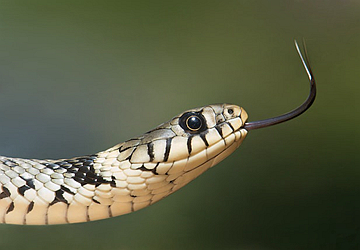Reptiles are intriguing creatures, but owing to their poisonous nature, some of them may be harmful. Knowing how to recognize poisonous reptiles is critical for your own safety and the protection of others around you. In this detailed article, we will offer you ten crucial recommendations to help you properly identify poisonous reptiles and stay safe in reptile-infested places.
Understanding the poisonous reptiles that live in your area is the first step in reptile identification. There may be different poisonous reptile species on different continents, nations, and even states. It is critical to investigate and become acquainted with the poisonous reptiles indigenous to your area. In North America, common poisonous reptiles include rattle reptiles, copperheads, and coral reptiles, as well as vipers and cobras in other regions of the world.

Observing the reptile's head form is one of the most reliable techniques to distinguish poisonous reptiles from non-deadly reptiles. Most poisonous reptiles have triangular or arrow-shaped heads, whereas non-deadly reptiles have rounder, longer heads. The head form of a poisonous reptile is caused by specialized venom glands, which give it a unique look.
Examining the reptile's eyes can also help with identification. Deadly reptiles' pupils are often elliptical or slit-shaped, comparable to a cat's eyes. Non-deadly reptiles, on the other hand, typically have circular pupils. This distinction is especially important for differentiating between the two types of reptiles under low-light circumstances.
Many poisonous reptiles have a unique heat-sensing organ called the pit, which is placed on either side of the head between their eye and nose. This pit, which is missing in non-deadly reptiles, permits them to identify warm-blooded prey. If you see these holes in the reptile's head, be cautious since it might be poisonous.
Reptile scale patterns differ between deadly and non-deadly reptiles. The underside of the tails of most poisonous reptiles has a single row of scales, whereas non-deadly reptiles often have two rows. Furthermore, poisonous reptiles frequently have coarser scales than their non-dead counterparts.
Another distinguishing feature to look for is the reptile's tail. Many poisonous reptiles have short tails with a rattle at the end that they employ to warn predators. However, not all poisonous reptiles have rattles. Therefore, this trait should not be relied on primarily for identification. Keep a safe distance from any reptile with a rattling tail.
Understanding reptile behavior can provide important information regarding its poisonous nature. When confronted, deadly reptiles become more aggressive and exhibit protective behavior. To defend themselves, they may coil up, hiss, and strike. Non-deadly reptiles, on the other hand, are more prone to escape danger.

While color and pattern analysis are not perfect markers of deadliness, they might give useful indications. The vivid colors of deadly reptiles, such as red, yellow, and orange, serve as a warning to prospective predators. To fit in with their environment, non-deadly reptiles may have more muted colors or camouflage patterns.
Using field guides or smartphone applications developed for reptile identification may be highly beneficial for individuals who are new to reptile identification. These websites contain thorough information about the reptiles present in various areas, as well as visual aids for precise identification. For increased accuracy, always cross-reference information from different sources.
If you are unclear about the identity of a reptile and fear it is poisonous, do not attempt to handle or approach it. Seek the help of local wildlife specialists, reptile handlers, or professional herpetologists who are familiar with recognizing and handling reptiles. Your first focus should always be safety.
For numerous compelling reasons, staying safe from poisonous reptiles is critical. These reptiles contain powerful poisons that may be lethal to humans and other animals. Let's look at why you should prioritize your protection when it comes to dangerous reptiles:
Deadly reptile bites can be fatal. Envenomation can cause a variety of symptoms, including severe pain, swelling, tissue damage, organ failure, and, in extreme circumstances, death, depending on the reptile species and amount of poison administered. Avoiding poisonous reptiles reduces the likelihood of experiencing such perilous scenarios.
Even if a reptile bite does not end in death, it can cause long-term health problems. Following poisonous reptile contact, victims may have prolonged discomfort, loss of movement, and psychological distress. Staying safe protects human health and lessens the strain on healthcare services.
Deadly reptiles play an important role in their ecosystems. We reduce the need for unwanted reptile kills by remaining protected from these reptiles, which might damage the natural equilibrium. Responsible cohabitation with reptiles is critical for the conservation of biodiversity and the health of natural environments.
Reptile bites can have a considerable economic impact, particularly in areas where poisonous reptiles are common. Individuals and communities may lose workdays, incur medical bills, and experience decreased production as a result of these bites. We may avoid these economic losses by remaining protected from deadly reptiles.
Fear of deadly reptiles and misunderstandings about them can lead to confrontations between reptiles and people. These confrontations can lead to retaliatory killings, habitat degradation, and reptile population declines. People may be educated about reptile safety to help prevent confrontations and build peaceful coexistence.
Deadly reptile bites are not just dangerous to people; they may also be lethal to pets and animals. We can lessen the chance of our beloved animals meeting deadly reptiles by remaining safe and being aware of reptile-prone locations.
Outdoor activities such as hiking, camping, and environmental exploration are popular among outdoor lovers. Understanding dangerous reptiles and adopting measures allows us to participate in these activities without unnecessary concern or risk.
Knowing how to recognize poisonous reptiles is critical for personal safety, particularly if you reside in or often visit reptile-infested areas. Following the ten safety precautions provided in this article can help you distinguish between deadly and non-deadly reptiles. When in doubt, always err on the side of caution and seek expert assistance. You may appreciate nature with confidence and peace of mind if you have this understanding.